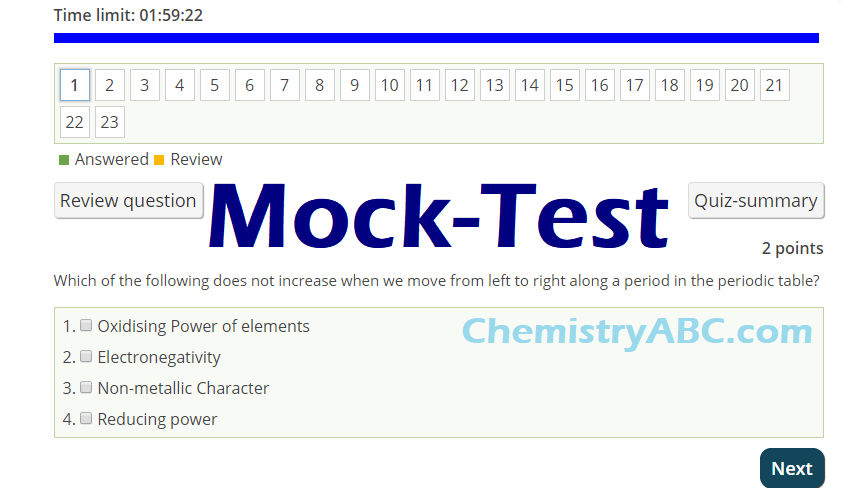NEET Mock Test Series
Preparing for the National Eligibility-cum-Entrance Test (NEET) is a challenging journey that demands dedication and practice. Two crucial components of the NEET chemistry section are inorganic and physical chemistry. Mock tests are a powerful tool to help you succeed in these areas.
Inorganic Chemistry: Inorganic chemistry often scares students with its vast array of elements, compounds, and reactions. Mock tests provide a structured approach to this subject. They enable you to gauge your understanding of concepts such as the periodic table, chemical bonding, and coordination compounds. These tests help you identify your weak points, allowing you to focus on them during your revision.
Physical Chemistry: Physical chemistry, on the other hand, delves into the fundamental principles that govern chemical reactions. Mock tests for this section can improve your problem-solving skills, especially in areas like thermodynamics, chemical kinetics, and equilibrium. Regular practice with these tests will boost your confidence and speed in solving numerical problems.
Here are some tips for using mock tests effectively:
- Consistency is Key: Take regular mock tests to track your progress.
- Analyze Your Mistakes: Carefully review and learn from the questions you answered incorrectly.
- Time Management: Practice under timed conditions to improve your speed.
Quiz-summary
0 of 19 questions completed
Questions:
- 1
- 2
- 3
- 4
- 5
- 6
- 7
- 8
- 9
- 10
- 11
- 12
- 13
- 14
- 15
- 16
- 17
- 18
- 19
Information
- This test consistes of previous year questions(PYQs) of NEET.
- Total duration of this test is 10 minutes.
- There is 1 section in the question paper consisting of 10 Single Option Correct MCQ questions.
- Each question is allotted 4 (Four) marks for correct response.
- No deduction for indicating incorrect response for each question.
- No deduction from the total score will be made if no response is indicated.
|
You must specify a text. |
|
|
You must specify an email address. |
You have already completed the quiz before. Hence you can not start it again.
Quiz is loading...
You must sign in or sign up to start the quiz.
You have to finish following quiz, to start this quiz:
Results
0 of 19 questions answered correctly
Your time:
Time has elapsed
You have reached 0 of 0 points, (0)
Categories
- Not categorized 0%
- Bio-Inorganic Chemistry 0%
- inorganic chemistry 0%
- Physical Chemistry 0%
| Pos. | Name | Entered on | Points | Result |
|---|---|---|---|---|
| Table is loading | ||||
| No data available | ||||
- 1
- 2
- 3
- 4
- 5
- 6
- 7
- 8
- 9
- 10
- 11
- 12
- 13
- 14
- 15
- 16
- 17
- 18
- 19
- Answered
- Review
-
Question 1 of 19
1. Question
4 pointsAcetone on treatment with CH3-Mg-I and on further hydrolysis gives
Correct
2-Methyl 2-propanol
Incorrect
2-Methyl 2-propanol
-
Question 2 of 19
2. Question
4 pointsCategory: inorganic chemistryTwo oxides of metal contain 27.6% and 30% oxygen respectively. If formula of first oxide is M3O4, then formula of second oxide is:
Correct
Given that, formula of first oxide = M3O4
Let mass of the metal = x
% of metal in M3O4 = (3x/ 3x+64) ×100but as given % age = (100-27.6) = 72.4 %
so, (3x/ 3x+64)×100 = 72.4or x = 56.
in 2nd oxide,
oxygen = 30%….so metal = 70%
so, the ratio is
M : O
70/56 : 30/16
1.25 : 1.875
2 : 3
so, 2nd oxide is M2O3Incorrect
Given that, formula of first oxide = M3O4
Let mass of the metal = x
% of metal in M3O4 = (3x/ 3x+64) ×100but as given % age = (100-27.6) = 72.4 %
so, (3x/ 3x+64)×100 = 72.4or x = 56.
in 2nd oxide,
oxygen = 30%….so metal = 70%
so, the ratio is
M : O
70/56 : 30/16
1.25 : 1.875
2 : 3
so, 2nd oxide is M2O3 -
Question 3 of 19
3. Question
4 pointsCategory: Physical Chemistry5.6 litres of a gas at N.T.P. are found to have a mass of 11 g. The molecular mass of the gas is
Correct
Answer:
5.6 liter=11g
22.4 liter=? (x) g
x= 22.4×11/5.6
x=44g
Thus, Molecular mass of gas is 44gIncorrect
Answer:
5.6 liter=11g
22.4 liter=? (x) g
x= 22.4×11/5.6
x=44g
Thus, Molecular mass of gas is 44g -
Question 4 of 19
4. Question
4 pointsCategory: Physical ChemistryThe crystalline salt, Na2SO4.xH2O on heating loses 55.9% of its weight. The formula of the crystalline salt is
Correct
Answer:
Molar mass of salt = (2 × 23) + 32 + (16 × 4) + x × 18
= 142 + 18xOn heating it will lose water and become anhydrous.
55.9% mass is the mass of waater in Na2SO4.xH2O.
Mass by Mass% = (mass / molar mass of compound) × 100
mass of water = 18x
55.9 = (18x / 142 + 18x) × 100
55.9(142 + 18x) = 1800x
7937.8 + 1006.2x = 1800x
x = 9.99
x = 10 (approx.)
So, the molecular formula of compound is Na2SO4.10H2O.Incorrect
Answer:
Molar mass of salt = (2 × 23) + 32 + (16 × 4) + x × 18
= 142 + 18xOn heating it will lose water and become anhydrous.
55.9% mass is the mass of waater in Na2SO4.xH2O.
Mass by Mass% = (mass / molar mass of compound) × 100
mass of water = 18x
55.9 = (18x / 142 + 18x) × 100
55.9(142 + 18x) = 1800x
7937.8 + 1006.2x = 1800x
x = 9.99
x = 10 (approx.)
So, the molecular formula of compound is Na2SO4.10H2O. -
Question 5 of 19
5. Question
4 pointsCategory: inorganic chemistry0.5 g of a metal on oxidation gave 0.79 g of its oxide. The equivalent weight of the metal is (approximately)
Correct
Given,
Mass of metal = 0.5 g
Mass of oxide = 0.79 g
First we have to calculate the Mass of Oxygen in metal oxide.
Mass of Oxygen = Mass of oxide – Mass of Metal = 0.79 – 0.5 = 0.29 g
The equivalent weight of oxygen is 8 g/eq.
0.29 g of oxygen combines with the 0.5 g of metal
8 g of oxygen combines with of metal.
Therefore, the equivalent weight of metal is 13.793 g/eq.
Incorrect
Given,
Mass of metal = 0.5 g
Mass of oxide = 0.79 g
First we have to calculate the Mass of Oxygen in metal oxide.
Mass of Oxygen = Mass of oxide – Mass of Metal = 0.79 – 0.5 = 0.29 g
The equivalent weight of oxygen is 8 g/eq.
0.29 g of oxygen combines with the 0.5 g of metal
8 g of oxygen combines with of metal.
Therefore, the equivalent weight of metal is 13.793 g/eq.
-
Question 6 of 19
6. Question
4 pointsCategory: inorganic chemistryAir contains nearly 20% oxygen by volume. The volume of air needed for complete combustion of 100 cc of acetylene will be
Correct
2 C2H2 + 5O2 → 4CO2 + 2 H2O
In this reaction, we can see that, 2 moles of C2H2reacts with 5 moles of O2
Or, 1 mole of C2H2 reacts with 5/2 moles of O2
Under standard conditions, we can say that:
22.44 L of C2H2 reacts with (5/2) x 22.4 L moles of O2
So, 100 cc of C2H2 will reacts with (5/2) x 100 cc = 250 cc of O2 .But, since air contains 20 % of oxygen by volume, the amount of air needed to react with 100 cc of C2H2 will be = 250 x (100/20) = 1250 cc of air.
Incorrect
2 C2H2 + 5O2 → 4CO2 + 2 H2O
In this reaction, we can see that, 2 moles of C2H2reacts with 5 moles of O2
Or, 1 mole of C2H2 reacts with 5/2 moles of O2
Under standard conditions, we can say that:
22.44 L of C2H2 reacts with (5/2) x 22.4 L moles of O2
So, 100 cc of C2H2 will reacts with (5/2) x 100 cc = 250 cc of O2 .But, since air contains 20 % of oxygen by volume, the amount of air needed to react with 100 cc of C2H2 will be = 250 x (100/20) = 1250 cc of air.
-
Question 7 of 19
7. Question
4 pointsCategory: inorganic chemistryA solution of 10 ml(M/10) FeSO4 was titrated with KMnO4 solution in acidic medium. The amount of KMnO4 used will be
Correct
The equation of the Mn2+ in acidic medium will be-
MnO4– + 8H++ 5 Fe2+ → Mn2++ 5Fe3+ +4H2O.
We can balance the reaction by using redox balancing of acid and base.
So, we know from the equation that 5 moles of iron react to form 1 mole of Mn+2.
Thus, we can say that (10×0.1) moles of iron will react with the (10×0.1/5) moles of Manganese ions, which will be 0.2 thus, 10ml volume of KMnO4 and 0.02M moles of KMnO4. We will get the same result if we use M1V1 = M2V2 formulae.
Incorrect
The equation of the Mn2+ in acidic medium will be-
MnO4– + 8H++ 5 Fe2+ → Mn2++ 5Fe3+ +4H2O.
We can balance the reaction by using redox balancing of acid and base.
So, we know from the equation that 5 moles of iron react to form 1 mole of Mn+2.
Thus, we can say that (10×0.1) moles of iron will react with the (10×0.1/5) moles of Manganese ions, which will be 0.2 thus, 10ml volume of KMnO4 and 0.02M moles of KMnO4. We will get the same result if we use M1V1 = M2V2 formulae.
-
Question 8 of 19
8. Question
4 pointsCategory: Physical ChemistryAt S.T.P. the density of CCl4 vapour in g/L will be nearest to
Correct
Molecular Weight of CCl₄ = 35.5 + 12 x 4 = 154
1 mole CCl₄ vapour=154 g
According to Avogadro’s hypothesis we know that the molar volume of a gas at STP is 22.4 litres
= 154/22.4 = 6.87Incorrect
Molecular Weight of CCl₄ = 35.5 + 12 x 4 = 154
1 mole CCl₄ vapour=154 g
According to Avogadro’s hypothesis we know that the molar volume of a gas at STP is 22.4 litres
= 154/22.4 = 6.87 -
Question 9 of 19
9. Question
4 pointsCategory: inorganic chemistryThe law of multiple proportions was proposed by
Correct
Dalton’s law of multiple proportions is part of the basis for modern atomic theory, along with Joseph Proust’s law of definite composition (which states that compounds are formed by defined mass ratios of reacting elements) and the law of conservation of mass that was proposed by Antoine Lavoisier.
Incorrect
Dalton’s law of multiple proportions is part of the basis for modern atomic theory, along with Joseph Proust’s law of definite composition (which states that compounds are formed by defined mass ratios of reacting elements) and the law of conservation of mass that was proposed by Antoine Lavoisier.
-
Question 10 of 19
10. Question
4 pointsCategory: Physical ChemistryThe anode rays were discovered by
Correct
The discovery of protons can be attributed to Rutherford. In 1886 Goldstein discovered existence of positively charged rays in the discharge tube by using perforated cathode. These rays were named as anode rays or cannal rays.
Incorrect
The discovery of protons can be attributed to Rutherford. In 1886 Goldstein discovered existence of positively charged rays in the discharge tube by using perforated cathode. These rays were named as anode rays or cannal rays.
-
Question 11 of 19
11. Question
4 pointsCategory: inorganic chemistryWhich of the following transitions of electrons in the hydrogen, atom will emit maximum energy ?
Correct
energy is given by following formulae,
E = RZ2hc( 1 − 1 ) n12 n22 E will be highest when the transition from n3→n2
Incorrect
energy is given by following formulae,
E = RZ2hc( 1 − 1 ) n12 n22 E will be highest when the transition from n3→n2
-
Question 12 of 19
12. Question
4 pointsCategory: inorganic chemistryThe uncertainity found from the uncertainity principle Δx.Δp=h/4 π is
Correct
Δx.Δp ≧ h/4π
So by the equation given in the question, the uncertainity value will be the least.Incorrect
Δx.Δp ≧ h/4π
So by the equation given in the question, the uncertainity value will be the least. -
Question 13 of 19
13. Question
4 pointsCategory: inorganic chemistryThe number of orbitals in any shell (n) is equal to
Correct
Maximum number of electrons can be accommodated in a shell of principal quantum number n is 2n2. Since each orbital can accommodate only 2 electrons, maximum number of orbitals =2n2/2= n2
Incorrect
Maximum number of electrons can be accommodated in a shell of principal quantum number n is 2n2. Since each orbital can accommodate only 2 electrons, maximum number of orbitals =2n2/2= n2
-
Question 14 of 19
14. Question
4 pointsCategory: inorganic chemistryThe maximum number of 4f electrons having spin quantum number s= (-1/2) is
Correct
Total no. of electrons in F- subshell = 14 (when we include both spin +1/2 & – 1/2)
But maximum no. of electrons = 7 if only one spin either – 1/2 or +1/2.Incorrect
Total no. of electrons in F- subshell = 14 (when we include both spin +1/2 & – 1/2)
But maximum no. of electrons = 7 if only one spin either – 1/2 or +1/2. -
Question 15 of 19
15. Question
4 pointsCategory: inorganic chemistryThe number of unpaired electrons in Cu+ (Z= 29) is
Correct
The electronic configuration of Cu is,
1s22s22p63s23p64s13d10
The reason for abnormal electronic configuration of Cu is because of the half-filled and fully-filled configuration are the more stable configuration. In this configuration, the d-subshell is fully-filled and s-subshell is half-filled which makes the Cu more stable.
Now, for getting a positive charge, it has to lose 1 electron which will be removed from the outermost 4s orbital and hence all the remaining electrons will be paired leading to 0 unpaired electrons
Incorrect
The electronic configuration of Cu is,
1s22s22p63s23p64s13d10
The reason for abnormal electronic configuration of Cu is because of the half-filled and fully-filled configuration are the more stable configuration. In this configuration, the d-subshell is fully-filled and s-subshell is half-filled which makes the Cu more stable.
Now, for getting a positive charge, it has to lose 1 electron which will be removed from the outermost 4s orbital and hence all the remaining electrons will be paired leading to 0 unpaired electrons
-
Question 16 of 19
16. Question
4 pointsCategory: inorganic chemistryThe electrons present in K-shell of the atom will differ in
Correct
Two electrons in K-shell will differ in spin quantum number.
They will have same values for the principal quantum number, azimuthal quantum number, and magnetic quantum number.For first electron, n=1,l=0,m=0,s=+1/2
For second electron, n=1,l=0,m=0,s=−1/2Incorrect
Two electrons in K-shell will differ in spin quantum number.
They will have same values for the principal quantum number, azimuthal quantum number, and magnetic quantum number.For first electron, n=1,l=0,m=0,s=+1/2
For second electron, n=1,l=0,m=0,s=−1/2 -
Question 17 of 19
17. Question
4 pointsCategory: inorganic chemistryConsider the following statements. The d-orbitals have
I. four lobes and two nodes
II. four lobes and one node
III. same sign in the opposite lobes
IV. opposite sign in the opposite lobes
Which of the above statements are correct ?
Correct
Total no of angular nodes = l (azimuthal quantum no.), so l=2 in d orbital, therefore number of nodes is 2 and it is a fact that opposite lobes have same signs and adjacent ones have opposite signs. there are 4 lobes in d orbital.
Incorrect
Total no of angular nodes = l (azimuthal quantum no.), so l=2 in d orbital, therefore number of nodes is 2 and it is a fact that opposite lobes have same signs and adjacent ones have opposite signs. there are 4 lobes in d orbital.
-
Question 18 of 19
18. Question
2 pointsCategory: Bio-Inorganic ChemistryThe biological functions of the cytochrome P450 and myoglobin are respectively,
Correct
Incorrect
-
Question 19 of 19
19. Question
2 pointsCategory: Bio-Inorganic ChemistryDeoxy-Hemocyanin is,
Correct
<div> <p><strong>Hemocyanin</strong>, a copper-containing protein chemically unlike hemoglobin, is found in some crustaceans.</p> <p><strong>Hemocyanin</strong> is B<strong>lue</strong> in <strong>colour</strong> when oxygenated and colourless when oxygen is removed.</p> </div> <div></div>
Incorrect
<div> <p><strong>Hemocyanin</strong>, a copper-containing protein chemically unlike hemoglobin, is found in some crustaceans.</p> <p><strong>Hemocyanin</strong> is B<strong>lue</strong> in <strong>colour</strong> when oxygenated and colourless when oxygen is removed.</p> </div> <div></div>
In summary, NEET mock tests in inorganic and physical chemistry can be your secret weapon to ace the exam. They provide a structured approach to tackle these challenging topics and fine-tune your problem-solving skills. So, incorporate them into your study routine and watch your confidence and performance soar. Good luck with your NEET journey!
NEET COURSES Biology Class 11 Biology Class 12 Chemistry Class 11 Chemistry Class 12 Physics Class 11 Physics Class 12 MOCK TEST SERIES NEET Mock Test Series AIIMS Mock Test Series JIPMER Mock Test Series SRMJEEE Mock Test Series AFMC Mock Test Series All NEET Test PAST YEAR PAPERS Biology Past Year Papers Class 11 Biology Past Year Papers Class 12 Chemistry Past Year Papers Class 11 Chemistry Past Year Papers Class 12 Physics Past Year Papers Class 11 Physics Past Year Papers Class 12 ADDITIONAL COURSES I.E. Irodov Solutions HC Verma Solutions DC Panday Solutions NEET Question & Answers NEET Exam Notification Revision Notes NEET Discussions




